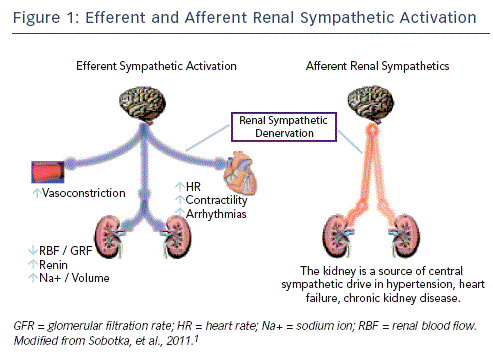Renal Sympathetic Nerves
Renal sympathetic nerves regulate kidney function, volume homeostasis, cardiac output and BP control.2
 Renal sympathetic activation results in volume retention, sodium reabsorption, reduction of blood flow and renin-angiotensin-aldosterone system activation.2 However, the kidney also has an extensive network of afferent unmyelinated fibres that transmit important sensory information to the central nervous system.2,3 Afferent fibres from the kidney have been shown to travel along with the sympathetic nerves at the level of the kidney and then enter the dorsal roots and project to neurons at both spinal and supraspinal levels. Most of the brainstem regions involved in cardiovascular control including the hypothalamus receive inputs from the renal afferents, which carry information to the central nervous system from renal chemo- and mechano-receptors.2,3 Direct electrical stimulation of the renal afferent nerves in animals can produce both sympathoinhibitory and sympathoexcitatory reflexes, illustrating the diverse functional nature of various populations of renal receptors.3
Renal sympathetic activation results in volume retention, sodium reabsorption, reduction of blood flow and renin-angiotensin-aldosterone system activation.2 However, the kidney also has an extensive network of afferent unmyelinated fibres that transmit important sensory information to the central nervous system.2,3 Afferent fibres from the kidney have been shown to travel along with the sympathetic nerves at the level of the kidney and then enter the dorsal roots and project to neurons at both spinal and supraspinal levels. Most of the brainstem regions involved in cardiovascular control including the hypothalamus receive inputs from the renal afferents, which carry information to the central nervous system from renal chemo- and mechano-receptors.2,3 Direct electrical stimulation of the renal afferent nerves in animals can produce both sympathoinhibitory and sympathoexcitatory reflexes, illustrating the diverse functional nature of various populations of renal receptors.3
In Figure 1, the interaction between efferent and afferent sympathetic activation and the kidney are shown. Activation of renal efferent sympathetic nerve fibres increases sodium and water retention, reduces renal blood flow and elevates renin release from juxtaglomerular apparatus, regulating BP. Renal nerves contain sensory afferent fibres, which enable communication with the central nervous system. Activation of renal afferent nerves itself elevate sympathetic nervous outflow to the kidney and other downstream organs (see Figure 1).
Renal Sympathetic Denervation
Recently, a catheter-based approach has been developed for renal sympathetic denervation (RDN). RDN significantly lowers BP in patients with therapy-resistant hypertension. Both, a proof-of-concept trial (Symplicity HTN-14), including 50 patients and a multicentre, prospective, randomised trial (Symplicity HTN-25) including 106 patients with resistant hypertension (systolic BP 160 millimetres of mercury [mmHg], >150 mmHg for type 2 diabetes) despite receiving 3 antihypertensive drugs) demonstrated that RDN significantly lowered BP. Systolic BP in these clinical trials was reduced by 25-32 mmHg. Three hundred and forty-six uncontrolled hypertensive patients, separated according to daytime ambulatory BP monitoring into 303 with true resistant (office systolic BP 172 mmHg; 24-hour systolic BP 154 mmHg) and 43 with pseudoresistant hypertension (office systolic BP 161 mmHg; 24-hour systolic BP 121 mmHg), were analysed in another study.6 At three, six and 12 months follow-up, office systolic BP was reduced by 21/23/27 mmHg and office diastolic BP by 8/9/11 mmHg, respectively. In patients with true treatment resistance there was a significant reduction with RDN in 24-hour systolic BP (-10/-10/-11 mmHg), diastolic BP (-4/-4/-7 mmHg), maximum systolic BP (-11/-10/-6 mmHg) and minimum systolic BP (-6/-9/-13 mmHg) at three, six and 12 months, respectively. There was no effect on ambulatory BP monitoring in pseudoresistant patients, whereas office BP was reduced to a similar extent.6
A multicentre, prospective SYMPLICITY HTN-3 study, which completed enrollment, will evaluate the safety and efficacy (including 24-hour BP measurements) of RDN in approximately 600 patients with resistant hypertension.7 In contrast to the Symplicity HTN-1 and HTN-2 trials, SYMPLICITY HTN-3 is a single-blind study with one group undergoing a sham procedure. This design will hopefully address the question of whether placebo-like effects contribute to the observed outcome after RDN.
Mechanistically, it has been observed that the procedure resulted in a 47 % reduction of renal norepinephrine spillover measured with a radiochemical tracer methodology using 3H-norepinephrine.4,5 Interestingly, firing of single sympathetic vasoconstrictor fibres, measured by single muscle sympathetic nerve activity were reduced by 37 %.8 These findings indicate a combined modulation of efferent and afferent signalling at the kidney by RDN.